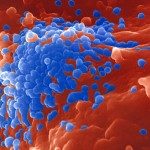Link to Pubmed [PMID] – 25645213
Clin. Infect. Dis. 2015 May;60(10):1559-68
BACKGROUND: Although human immunodeficiency virus (HIV)-infected women are at high risk for anal cancer, few data have been published on prevalence of and risk factors for anal precancer and potential screening strategies in this risk group.
METHODS: A cross-sectional anal screening study was nested in a gynecological cohort of HIV-infected women. Anal swab specimens were collected for cytology and human papillomavirus (HPV) testing. High-resolution anoscopy, with biopsy when indicated, was systematically performed.
RESULTS: Among the 171 enrolled women, median age was 47.3 years and 98% were receiving combination antiretroviral therapy. Median CD4(+) count was 655 cells/µL and HIV load was <50 copies/mL in 89% of subjects. High-grade anal intraepithelial neoplasia or worse (HG-AIN+) was diagnosed in 12.9% (n = 21). In multivariable analysis, a history of cervical squamous intraepithelial lesion (odds ratio [OR], 4.2; 95% confidence interval [CI], 1.1-16.4) and anal HPV-16 infection (OR, 16.1; 95% CI, 5.4-48.3) was associated with increased risk of HG-AIN+. Abnormal anal cytology and HPV-16 infection performed best as a screening strategy for HG-AIN+ histology, with positive likelihood ratios of 3.4 (95% CI, 2.3-5.1) and 4.7 (95% CI, 2.5-8.7) and negative likelihood ratios of 0.2 (95% CI, .07-.8) and 0.4 (95% CI, .2-.9), respectively.
CONCLUSIONS: HIV-infected women with a history of HPV-associated cervical disease are at increased risk for HG-AIN+ and should be offered anal cancer screening. Anal cytology and HPV-16 genotyping had the best screening performance. Anal cytology is easy to perform routinely; it may be the best candidate for screening for HG-AIN among HIV-infected women.

